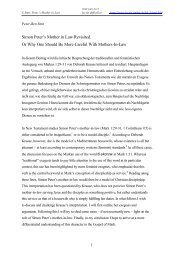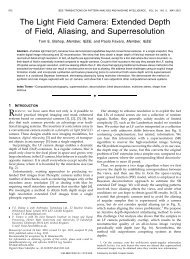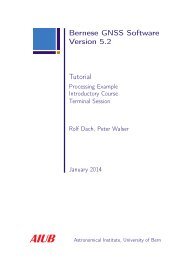Minimal Models of Adapted Neuronal Response to In Vivo–Like ...
Minimal Models of Adapted Neuronal Response to In Vivo–Like ...
Minimal Models of Adapted Neuronal Response to In Vivo–Like ...
Create successful ePaper yourself
Turn your PDF publications into a flip-book with our unique Google optimized e-Paper software.
Adapting Rate <strong>Models</strong> 2121<br />
References<br />
Abbott, L. F., & van Vreeswijk, C. (1993). Asynchronous states in networks <strong>of</strong><br />
pulse-coupled oscilla<strong>to</strong>rs. Phys. Rev. E, 48, 1483–1490.<br />
Amit, D. J., & Brunel, N. (1997). Model <strong>of</strong> global spontaneous activity and<br />
local structured (learned) delay activity during delay. Cerebral Cortex, 7, 237–<br />
252.<br />
Amit, D. J., & Tsodyks, M. V. (1991). Quantitative study <strong>of</strong> attrac<strong>to</strong>r neural<br />
network retrieving at low spike rates: I. Substrate-spikes, rates and neuronal<br />
gain. Network, 2, 259–273.<br />
Amit, D. J., & Tsodyks, M. V. (1992). Effective neurons and attrac<strong>to</strong>r neural<br />
networks in cortical environment. Network, 3, 121–137.<br />
Brunel, N. (2000). Persistent activity and the single cell f-I curve in a cortical<br />
network model. Network, 11, 261–280.<br />
Brunel, N., & Hakim, V. (1999). Fast global oscillations in networks <strong>of</strong> integrateand-fire<br />
neurons with low firing rates. Neural Computation, 11, 1621–1671.<br />
Brunel, N., & Latham, P. (2003). Firing rate <strong>of</strong> the noisy quadratic integrate-andfire<br />
neuron. Neural Computation, 15, 2281–2306.<br />
Brunel, N., & Sergi, S. (1998). Firing frequency <strong>of</strong> leaky integrate-and-fire neurons<br />
with synaptic currents dynamic. J. Theor. Biol., 195, 87–95.<br />
Brunel, N., & Wang, X. J. (2001). Effects <strong>of</strong> neuromodulation in a cortical network<br />
model <strong>of</strong> object working memory dominated by recurrent inhibition. Journal<br />
<strong>of</strong> Computational Neuroscience, 11, 63–85.<br />
Burkitt, A. N. (2001). Balanced neurons: Analysis <strong>of</strong> leaky integrate-and-fire<br />
neurons with reversal potentials. Biol. Cybern., 85, 247–255.<br />
Burkitt, A. N., Meffin, H., & Grayden, D. B. (2003). Study <strong>of</strong> neuronal gain in<br />
a conductance-based leaky integrate-and-fire neuron model with balanced<br />
excita<strong>to</strong>ry and inhibi<strong>to</strong>ry input. Biol. Cybern., 89, 119–125.<br />
Chance, F. S., Abbott, L. F., & Reyes, A. D. (2002). Gain modulation from background<br />
synaptic input. Neuron, 35, 773–782.<br />
Destexhe, A., Rudolph, M., Fellous, J. M., & Sejnowski, T. J. (2001). Fluctuating<br />
dynamic conductances recreate in-vivo like activity in neocortical neurons.<br />
Neuroscience, 107, 13–24.<br />
Ermentrout, B. (1996). Type I membranes, phase resetting curves, and synchrony.<br />
Neural Computation, 8, 979–1001.<br />
Ermentrout, B. (1998). Linearization <strong>of</strong> f-I curves by adaptation. Neural Computation,<br />
10(7), 1721–1729.<br />
Ermentrout, G. B., & Kopell, N. (1986). Parabolic bursting in an excitable system<br />
coupled with a slow oscillation. SIAM J. Appl. Math., 46, 233–253.<br />
Fleidervish, I., Friedman, A., & Gutnick, M. J. (1996). Slow inactiavation <strong>of</strong><br />
Na + current and slow cumulative spike adaptation in mouse and guinea-pig<br />
neocortical neurones in slices. J. Physiol. (Cambridge), 493, 83–97.<br />
Fourcaud, N., & Brunel, N. (2002). Dynamics <strong>of</strong> the firing probability <strong>of</strong> noisy<br />
integrate-and-fire neurons. Neural Computation, 14, 2057–2110.<br />
Fuhrmann, G., Markram, H., & Tsodyks, M. (2002). Spike frequency adaptation<br />
and neocortical rhythms. J. Neurophysiology, 88, 761–770.
















